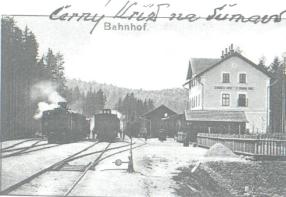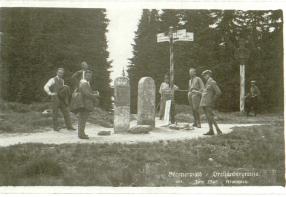HISTORY OF THE VILLAGE
Stožec was founded as a settlement of wood-cutters. We do not know the precise year of its foundation, but the first written reference about the village comes from 1769.
From the village history it is worth mentioning the greatest battle of poachers in Europe, which took place in February 1850, when the Bavarian poachers attacked the loggers who only managed to fortify themselves against the attack in the local hotel Pstruh. The fight resulted in several victims and many injured on both sides. There were still many bullets found in the beams of the timbered building during its reconstruction in 1930's.
In the beginning of the 20th century Stožec went through its greatest boom. A railway was conducted to the village in 1910. In the same period, one of the last local railway lines in Bohemia was built, which connected Černý Kříž, Stožec and the state frontier in Nové Údolí. This eight-kilometre track enabled connection of the South-Bohemian and the Šumava railways with the railway network in Bavaria. The number of the village inhabitants grew gradually. In 1900 there were 2733 people, while in 1930 even 2811 people (the numbers refer to the community including the attached settlements with the most populated one being České Žleby /Böhmisch Röhren/).
The turning point came after the World War II. The border zone was depopulated (displacement of the majority of people of German nationality). Only 599 people remained in Stožec and their number was further falling, mainly due to the repressive measures applied to the whole area neighbouring immediately with "West" Germany. Today the village has only about 200 permanent residents (about 120 in the village of Stožec, 60 in the settlement of České Žleby and only 9 in the settlement of Dobrá). The village nowadays belongs amongst one of the favourite tourist destinations in the Volary area.
From the village history it is worth mentioning the greatest battle of poachers in Europe, which took place in February 1850, when the Bavarian poachers attacked the loggers who only managed to fortify themselves against the attack in the local hotel Pstruh. The fight resulted in several victims and many injured on both sides. There were still many bullets found in the beams of the timbered building during its reconstruction in 1930's.
In the beginning of the 20th century Stožec went through its greatest boom. A railway was conducted to the village in 1910. In the same period, one of the last local railway lines in Bohemia was built, which connected Černý Kříž, Stožec and the state frontier in Nové Údolí. This eight-kilometre track enabled connection of the South-Bohemian and the Šumava railways with the railway network in Bavaria. The number of the village inhabitants grew gradually. In 1900 there were 2733 people, while in 1930 even 2811 people (the numbers refer to the community including the attached settlements with the most populated one being České Žleby /Böhmisch Röhren/).
The turning point came after the World War II. The border zone was depopulated (displacement of the majority of people of German nationality). Only 599 people remained in Stožec and their number was further falling, mainly due to the repressive measures applied to the whole area neighbouring immediately with "West" Germany. Today the village has only about 200 permanent residents (about 120 in the village of Stožec, 60 in the settlement of České Žleby and only 9 in the settlement of Dobrá). The village nowadays belongs amongst one of the favourite tourist destinations in the Volary area.


